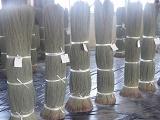Kumamoto Kensan Igusa
| Registration Number | 8 |
|---|---|
| Name of the GI | Kumamoto Kensan Igusa,KUMAMOTO-IGUSA, KUMAMOTO-RUSH |
| Class | Others |
| Date of Protection | 2016/02/02 |
| Producing Area |
Kumamoto Prefecture
Yatsushiro city, Hikawa town, Uki city |
| Applicant - Name and Address | JA Yatsushiro area JA Kumamoto Uki |
KUMAMOTO-RUSH is the soft rush turned into beautiful high-quality tatami facing by traditional "mud dyeing" method. The white cotton-like structure inside the soft rush forms a dense honeycomb structure, which have excellent humidity adjusting and harmful substance adsorption properties.
Kumamoto Prefecture is regarded as a representative region of Japan for soft rush, because soft rush grown in Yatsushiro City, Hikawa Town, and Uki City in Kumamoto Prefecture account for about 90% of the nation's tatami production.
The process which traditionally accompanies cultivation is "mud dyeing", in which soft rush immediately after harvesting are evenly immersed in a solution prepared by dissolving natural soil at a suitable concentration in water. The mud adhered to each and every soft rush allows them to dry evenly, and the mud coating prevents the chlorophyll and soft rush's internal structure from getting damaged. This is how good Igusa with nice gloss and color tone are made. Also, since excessive drying is suppressed, it is an important process to maintain the quality of the soft rush for a long time.
This paddy field region supports the nation's largest production volume with abundant water resources such as the "Kuma River" flowing to the Yatsushiro plain, and underground water. As climatic features, the temperature in the paddy field drops to nearly freezing point in the winter, from January to March, and rises again in the summer. Also, the contrast between the long sunshine hours of May and the short sunshine hours of June helps the soft rush stems become longer and cultivating high quality soft rush in high yield. Once soft rush with long stalks are woven into a tatami facing, it changes its appearance to a beautiful tatami facing with a uniform color.
The history of soft rush cultivation in the Yatsushiro area goes back a long way. It is reported that it began when a local lord had soft rush cultivated in the territory in the 1500s, and encouraged it under special protection. Until the Meiji Restoration, cultivation was limited to several villages, but it was gradually established as a local industry, spreading out to the Uki/Kuma areas around Yatsushiro, and by 1970, it had become the biggest production area in Japan.


